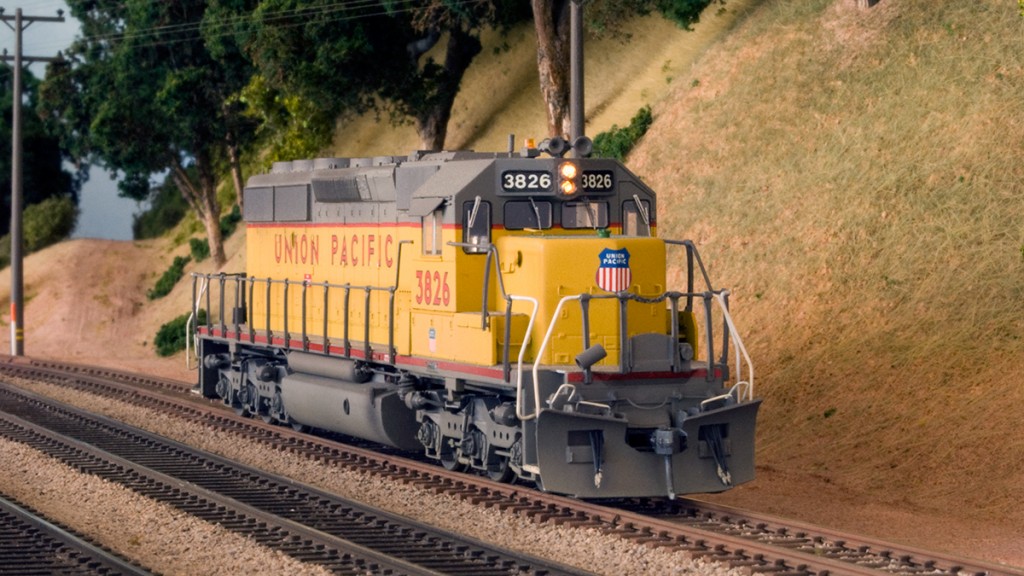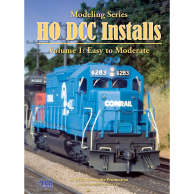
Athearn “Blue Box” SD40-2
Athearn “Blue Box” SD40-2, Union Pacific 3826
Overview
CV Programming – ESU LokSound 3.5
Review
Like many modelers, not all of my locomotives are new. Some of my favorites are actually old Athearn “blue box” units that I’ve tuned, re-motored, detailed, and painted. With some work these locomotives can look great and run every bit as good as newer models, but they are not set up for DCC at all.
On the DVD I show how I installed an ESU LokSound 3.5 sound decoder in this model, including wiring the headlights and rooftop beacon. Even if you have a unit with the original motor, the techniques are still applicable.
CV Programming – ESU LokSound 3.5
Only common CVs or those that were changed from their default values are listed. Some settings reflect my personal preferences for speed matching and performance. The LokSound 3.5 has an outstanding BEMF implementation, and I left most of the BEMF-related CVs at their defaults.
| CV | Value (decimal) | Notes |
| 2 (start speed) | 3 | This controls the minimum voltage applied to the motor at speed step 1. |
| 3 (acceleration) | 28 | This controls how quickly the locomotive changes speed when accelerating. |
| 4 (deceleration) | 23 | This controls how quickly the locomotive changes speed when decelerating. |
| 5 (top speed) | 41 | This controls the maximum voltage applied to the motor at full throttle. |
| 6 (mid speed) | 21 | This controls the voltage applied to the motor at half throttle. |
| 17 (extended address) | 206 | For locomotives with a 4-digit address, CV 17 and 18 together determine the address. To be honest I never try to set these manually. My Digitrax system does all this automatically for me when I program a 4-digit address. |
| 18 (extended address) | 242 | see CV17 |
| 29 (configuration) | 38 | The setting of CV29 is complex. See your decoder instructions. Your DCC system may set CV29 for you when programming your locomotive’s address. If you need to modify CV29, it’s best to do it after setting the address. |
| 53 (control reference) | 32 | Reducing this value from the default has the effect of lowering the starting speed of the locomotive (though it is still good with the default value). LokSound decoders are great at low speed crawling, making for amazingly smooth starts and stops. |
| 63 (volume) | 32 | This is the overall sound volume. |
| 121 (volume) | 64 | This is the horn sound volume. |
| 122 (volume) | 21 | This is the bell sound volume. |
| 123 (volume) | 32 | This is the auxiliary sound volume (prime mover, brake squeal, and everything else). |
| 172 (F5 button forward B) | 1 | Setting this variable to 1 prevents the locomotive from slowing down when dynamic brakes are turned on with the F5 button. |
| 175 (F5 button reverse B) | 1 | see CV172 |
Locomotive
This locomotive has had just about everything done that is possible to do to an Athearn “blue box” drivetrain. I replaced the sintered iron wheels with nickel silver wheels from NWSL. The worms have additional thrust washers to eliminate end play. The motor was replaced with a new one from A-line/Proto Power West. I tuned the splined shafts so that they make very little noise. As a result, this is a very smooth, quiet locomotive. It has an A-line cradle weight under the motor, too, which makes it heavy enough to be a good puller.
I started with an undecorated shell, added details. I painted the model myself and used Microscale decals for the markings. I chose the number because there is a picture of the full-sized 3826 in one of my UP motive power annuals, and I liked that it is an ex-Katy unit.
Tip: In discussions about tuning Athearn diesels, someone will usually suggest using toothpaste to “polish” the gears. Don’t. I have ruined gearboxes doing that, so I would advise against it. First take the trucks off the model and roll them. If they roll freely, don’t do anything to them. They won’t get any better. If there is a problem with the gears, I have had better luck installing brand new Athearn gears. These are available from good hobby shops or online.
Decoder
The LokSound 3.5 delivers outstanding performance and solid sound. I especially like the fact that the LokSounds don’t generally require much if any CV tweaking to achieve stellar performance. I have tried many brands of decoders and I have yet to find anything that will make a locomotive run better than a LokSound.
The sound quality of the LokSound 3.5 is largely dependent on the sound set that’s programmed into the decoder’s memory. The EMD sounds are generally very good, especially at idle. The Leslie 3-chime horn is not my favorite, but maybe that’s realistic. Newer LokSound Select decoders have better horn sounds, and they’re wired the same way as the 3.5s, so everything else about the install would still apply if you chose to go that route.
The LokSound 3.5 has the ability to load different or customized sound sets if you have a PC and the ESU LokSound Programmer hardware/software package. Thankfully, though, all of the features of the decoder aside from loading new sounds are accessible via CV programming.
Mac users need not feel left out. I have a Mac and run the LokSound Programmer software under Windows 7 using Parallels Desktop, an application that allows you to run PC software on the Mac!


Comments are closed.